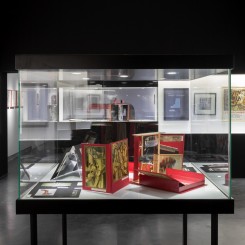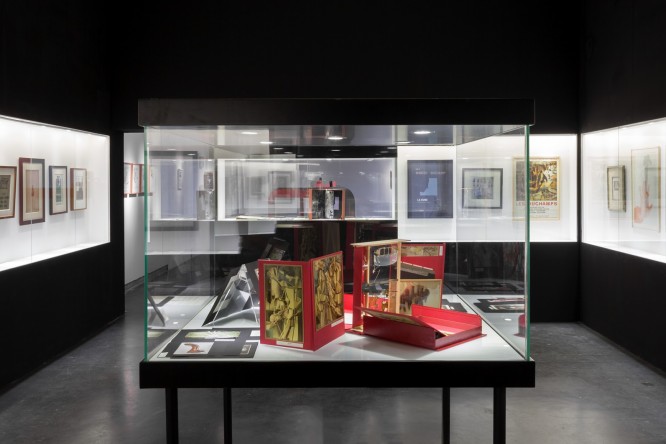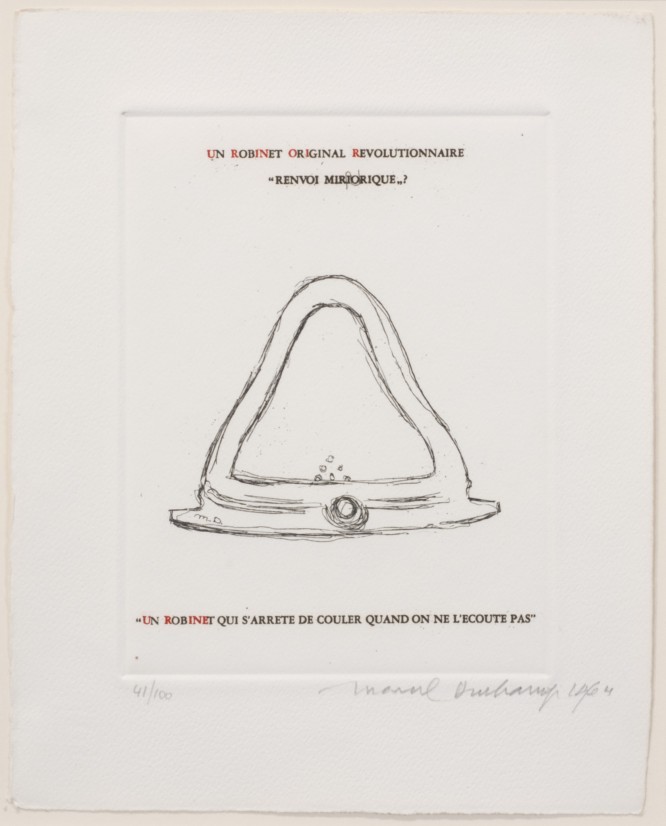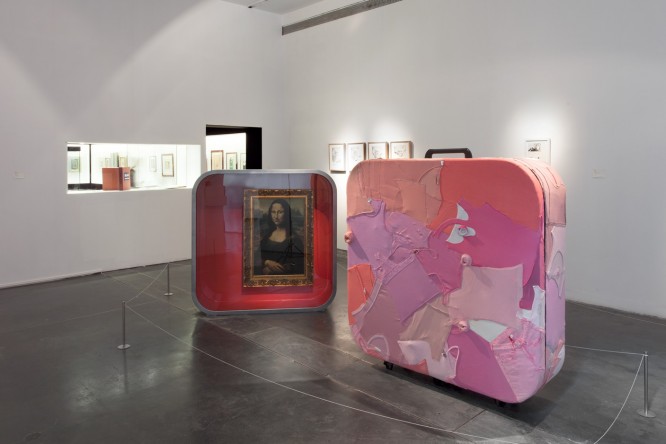DUCHAMP and/or/in CHINA
UCCA (798 Art District, No. 4 Jiuxianqiao Lu Chaoyang District, Beijing, China 100015), Apr 27 — June 16, 2013
“On | Off,” “See/Saw,” “and/or/in”…UCCA’s exhibition schedule has taken on an ambivalent tone recently. For “On | Off,” the young Chinese artist show, it recalls a certain curatorial (and political?) angst; in See/Saw, it fit the exhibition’s form. And for “DUCHAMP and/or/in CHINA,” with its hip ruptures into upper case, it is deliberately equivocal.
Not that a conclusion is necessarily desired from this show. Any exhibition including Duchamp’s work must straddle such a depth of attendant discourse as perhaps none other (at least of the 20th Century) has ignited. In 1969, Joseph Kosuth asserted that Duchamp was the Father of conceptualism — the first to posit the function of art as a question. Ai Weiwei (whose 1985 work “Hanging Man” in which a coat hanger is coerced into the shape of Duchamp’s profile is presented here) shares this view: “After Duchamp, the existence of any art, its value, is entirely conceptual”, he is quoted in the press materials as having said. This “Duchamp Effect” is the subject of endless art-work and debate.
At UCCA, “DUCHAMP and/or/in CHINA” brings his “Boîte-en-Valise” here for the first time, offers the “most comprehensive” show yet of Duchamp’s work in China and explores his influence on contemporary Chinese art. The first of these, at least, is cleanly realised. In the middle of the central room is arranged a miniature repro of sixty-nine works including “Fountain” (1917) and “The Large Glass” (1915-23). As a “comprehensive” show there is a large number of works here. Most are in paper or in written form on posters, for example. They gaze from glass cases that line the walls, a protective barrier between us and them. Duchamp’s more substantial pieces, of course, are kept at bay by the difficulties of transporting and insuring them.
“Influence” is an ambiguous and flexible term, often invoked but seldom questioned, and it is small wonder that this exhibition, which reaches for so much, troubles one as an anti-climax. The number of works and compact space (itself conceived ineffectually as a “Boîte-en-valise”) make the show feel somewhat bottlenecked. What and where is this influence? How to detect, attribute and interpret it, and with the right dose of art history? Such is Duchamp’s status as a forebear that his ideas, conversely, can seem veiled, and the man less a human artist than a sort of disembodied intellect(1). Duchamp conceived of his work like a feint for which a sense of mischief was integral; his own attitude to it was always unfixed (2).
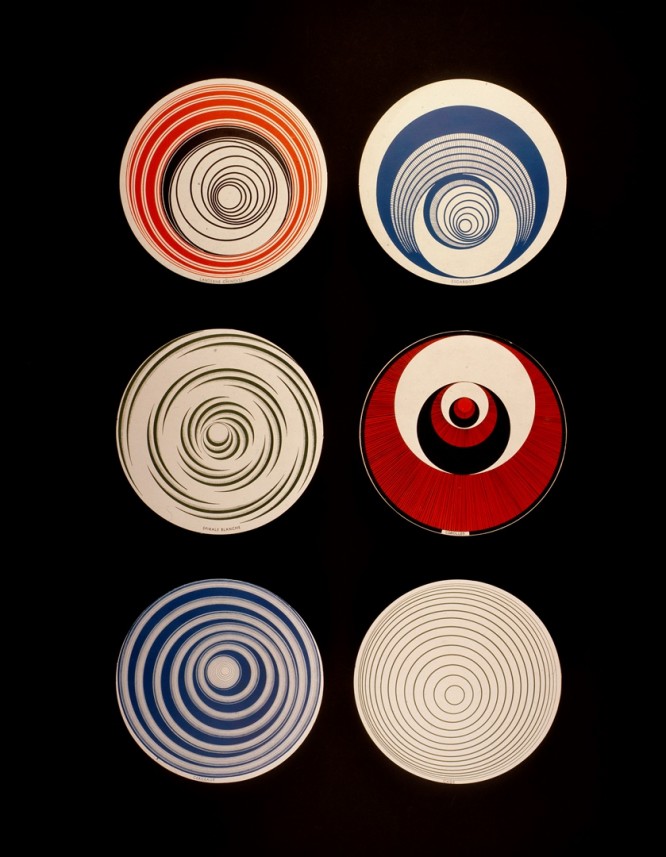
Marcel Duchamp, “Rotoreliefs (Optical Disks)”, set of six cardboard disks, supplied with a suspension unit, a wooden box covered with black velvet, supporting a motor on the back which drives a revolving turntable. Disks printed on both sides in color offset lithography, edition 75 from a complete edition of 150, each disk 20 cm diameter; turntable 24.8 cm diameter, box 37.5 x 37.5 x 8.5 cm, 1965
马塞尔•杜尚,“Rotoreliefs(光盘)”,一套六个硬纸板磁盘,配以悬挂装置;盖着黑色天鹅绒的木箱,支持背面驱动磁盘转动的马达。磁盘双面采用胶板印刷,完整版150中的版本75,每个磁盘直径20厘米,转盘24.8厘米,木箱37.5 x 37.5 x 8.5厘米,1965
But before criticism or praise, it is worth asking what the expectations of this show could have been. Seeing as it was surely Duchamp’s prerogative, if nothing else, to skirt and question things, I take this chance to evade the customary review format to put some questions to this exhibition. First of all, “How do you look?” And by this, I mean also mean what is your perspective on Duchamp and his legacy (not forgetting the impressive exhibition catalogue, nicknamed “the Bible” in some circles)? The show delivers a sense of Duchamp’s influence on these Chinese artists in no uncertain terms – they all used his work in positive and different ways. But perhaps a degree of uncertainty and a greater impression within the exhibition of the context with which Duchamp’s inheritance collided in China might have better illustrated this relationship; perhaps the suggestion of his influence, rather than its repeated affirmation, might have been more thought-provoking. This, however, is a personal feeling. The question of what this means for our (re)discovery of Duchamp is one that could and should be a continuing effect of the show. Ditto the Chinese artists – how to situate this Duchampian element in relation to their individual development? On a no-less simple level, which aspect of Duchamp or his output reappears in these Chinese works — how is his “influence” manifest? In other words, what have these artists “done” with what Duchamp did, or chose not to do (the negative always has its allure — Wang Luyan, whose work is here, denies the influence of Duchamp on his practice)?
One wonders, too, why this exhibition arrived in Beijing at this particular time. Of course, the workings of such a machine as UCCA remain largely hidden to the outside eye, but one likes to think that amid the still-nascent art scene in China, decisions about which artistic imports to bring over when, and how, have some kind of logic to them. After all, Beijing still lacks an institutional structure to deliver these kinds of shows, and UCCA is more than aware of its role in this sense. A related question here is what sort of background and expectations the show (if we can personify it this way) imagined meeting in Beijing – amongst the public and Chinese artists both mature and younger. Indeed, is the contemporary Chinese context a fertile one for thinking in terms of Duchamp’s project and themes?
What could the effect of this exhibition be on those Chinese artists whose work is featured here, something that it would be necessary to ask them in person, and which could make for engaging follow-up. One assumes that they have never seen their own work placed alongside those of Duchamp Himself, and artists’ impressions of their own shows are seldom explored; the subject of “influence” makes this a particularly tempting possibility. Then again, which Duchamp works are offered here – does the combination actually ‘match’ (in whatever way) from the perspective of the artists, let alone the audience? It must be said that these Duchamp pieces, except for the Boîte-en-Valise itself, are largely 2D – graphic interventions for example on posters and invitations; these line the walls not unlike art-historical wallpaper in the rooms of the contemporary. An enticing thought is what Duchamp himself might have thought of these Chinese works. It is an intriguing question, albeit to be ever left unanswered.
(1) Hopkins, D. (2006) Re-thinking the Duchamp Effect. In: Jones, A. (ed.) A Companion to Contemporary Art Since 1945. Blackwell, Malden, Mass., pp. 156.
(2) Ibid., 153.
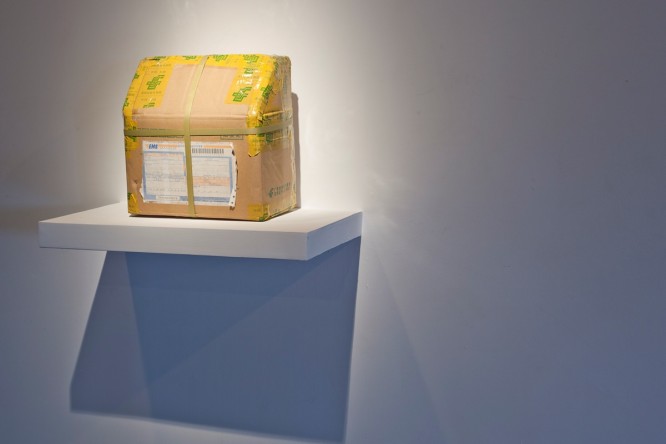
Polit-Sheer-Form Office, “Prize”, installation, cardboard box, unknown contents, 30 x 18 x 31.5 cm, 2010
政治纯形式办公室,《奖品》,装置,硬纸盒、内容不详,30 x 18 x 31.5厘米,2010

